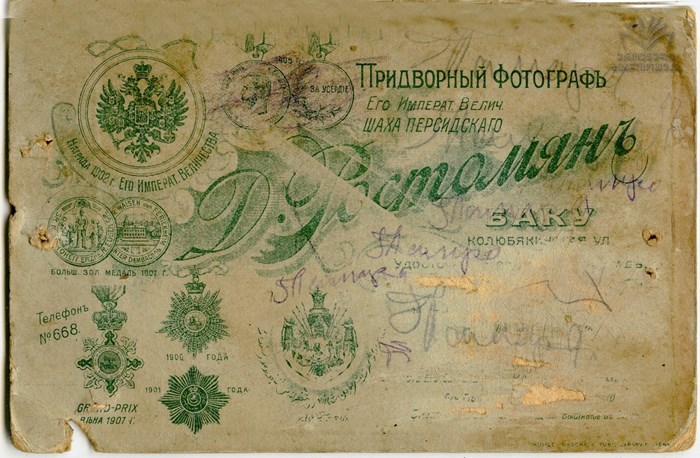
Davit Hambardzumi Rostomyan
1890 - 1910s
The studio D. Rostomyan was one of the largest and most prominent photographic establishments in Baku in the late 19th and early 20th centuries. The director, David Rostomyan, was originally from the town of Noukhi, and, perhaps, took his first professional steps there. His business in Baku was founded in 1893 and later moved to a two-story house located on the crossroad between Marinsky and Torgovaya streets. Memoirist Manaf Suleymanov writes that Rostomyan had a large staff consisting of five to six young women. They worked on the ground floor of the studio, taking care of daily administrative tasks and serving average customers. The responsibility for more serious orders was carried out by Rostomyan himself, who photographed officials, celebrities and representatives of the elite.(1)
As can be seen from Rostomyan's studio seal, he had Iranian citizenship and presented himself as an official photographer to the Persian Shah. The backstamps also list awards and medals received from Emperor Nikolay Alexandrovich, the Emir of Bukhara, the Shah of Iran and the Armenian Catholicos. The seals also note that Rostomyan had participated in an international exhibition in Vienna where he was awarded the Grand Prix. The photographer was also in competition with his own brother, Barsegh Rostomyan, whose pavilion was located in the administrative center of Baku, on the so-called ‘Parapet’ square.
The hundreds of portraits, which we know to have been produced at Rostomyan's pavilion, dramatically diverge in their qualities. They were clearly executed by different operators. The photographs depicting individuals from the lower and middle classes are extremely formulaic: they are made quickly and solely with the aim of achieving a ‘clean’ mimetic representation. Nevertheless, since these portraits reflect the entire panorama of the Baku’s multi-ethnic and class-based community, the value of such photographs today as historical and cultural evidence is considerable.
The fate of the photographer and his studio after the 1910s is unknown. Rostomyan remained a bachelor and had no heirs. In all likelihood, his pavilion was sold or closed several years before the Bolshevik Revolution.
1) Manaf Suleymanov. Dni Minuvshie (Istoricheskie ocherki) [Days Gone By (Historical Essays), in Russian], Baku, 1990
Nationality
Iranian, Armenian
Region
Azerbaijan, Russian Empire
City
Noukhi, Baku
Studio
D. Rostomyan
Activity
studio
Media
analogue photography
Bibliography
Dadayan, Khachatur. Hayery ev Bakun (1850tt-1920t.) [Armenian and Baku (1850s-1920), in Armenian], Yerevan, 2006
Suleymanov, Manaf. Dni Minuvshie (Istoricheskie ocherki) [Days Gone By (Historical Essays), in Russian], Baku, 1990
Collections
Lusadaran Armenian Photography Foundation, Yerevan; National Library of Georgia, Tbilisi; Ye. Charents Museum of Literature and Arts, Yerevan



